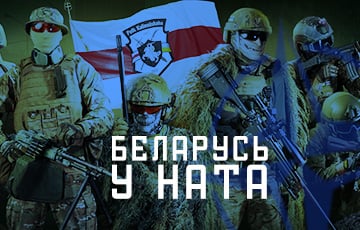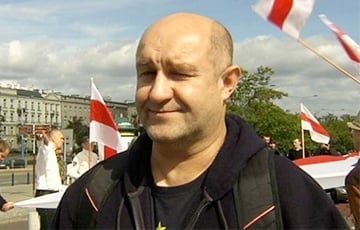Example Of Estonia: Why Neutrality Is Not For Belarus?
14- Silver Loit
- 16.06.2024, 21:40
- 18,584

Only NATO can protect our country.
The Charter97.org website continues publishing articles from a book by the European Belarus Foundation. Estonian diplomat Silver Loit wrote this article.
The ongoing war of Russia against Ukraine has changed the security situation around the Baltic Sea dramatically. Finland’s membership in NATO and Sweden’s application for NATO membership that will be accepted sooner or later have strengthened the security of the Baltic Sea region, developing its resilience against the single dangerous and potentially damaging local power – Russia. It all has happened in spite of Russia’s blatant ultimatum to NATO, the US and the OSCE on 17 December 2021 that attempted to impose Russia’s rules of the game on the West, again. Russia’s brutal war against Ukraine has had the opposite effect, as it was confirmed by the President of Finland Sauli Niinistö who addressed Vladimir Putin by saying, ’You caused this. Look at the mirror’. Symbolically and dramatically. It marked the end of the long-time Finnish neutrality, and it finally closed the chapter on two centuries of the policy of neutrality in the region.
For Estonia, the policy of neutrality had proven its weakness already a long time ago. The strong support for NATO in Estonia has been built on the foundation of Estonia’s tragic past.
At the beginning of Estonia’s independence, the concept of a policy of neutrality seemed quite appropriate for a new-born country that had felt the burden of the First World War. The Manifesto to the Peoples of Estonia, the founding declaration of the independent Republic of Estonia, proclaimed on 24 February 1918 in Tallinn, clearly stated that ’the Republic of Estonia wishes to maintain absolute political neutrality towards all neighbouring states and peoples and expects that they will equally respond with complete neutrality’. The quest for neutrality was very practical: tens of thousands of Estonians had fought in the battlefields of the First World War in the ranks of the Russian Army. The founders of independent Estonia did not want to take sides in the hostilities between collapsing empires.
Estonia was forced to move away from the idea of total neutrality already in the first days of its independence. On the second day of Estonia’s independence, Tallinn was occupied by the troops of imperial Germany. Germany was defeated in the World War and Estonia was attacked by Soviet Russia and the Baltic Landeswehr. Estonia won the War of Independence (1918–1920). The Allies – the United Kingdom, Finland, Latvia, Swedish and Danish volunteers, Baltic German units and the Russian White movement – supported Estonia. Thus, Estonia’s experience in its War of Independence clearly showed the need for reliable allies, and this need only increased when Estonia started to apply for full diplomatic recognition from the International community, especially from the members of the Entente. Soviet Russia was the first state that recognized Estonia de jure according to the Tartu Peace Treaty signed by the representatives of the two governments on 2 February 1920.
Russia unreservedly recognized ’the independence and autonomy of the State of Estonia’, and renounced ’voluntarily and for ever all rights of sovereignty formerly held by Russia over the Estonian people and territory by virtue of the former legal situation, and by virtue of International treaties, which, in respect of such rights, shall henceforth lose their force’ (Article 2). The Soviet side promised that ’should the perpetual neutrality of Estonia be internationally recognised, Russia undertakes to respect such neutrality and to join in guaranteeing it’ (Article 5). From the perspective of the wider security of the Baltic Sea, the parties agreed that ’in case of the neutralisation of the Gulf of Finland, the two contracting Parties undertake to accede to such neutralisation of the conditions drawn up by common agreement of the States concerned and established by international declarations relating hitherto; in case of the conclusion of any such international agreement, they also undertake to bring their naval forces, or a portion thereof, into conformity with the provisions of such International agreement’ (Article 6). The parties agreed to forbid all kinds of recruiting and mobilisation of official and unofficial forces that could be directed against the other contracting party (Article 6). The following Peace treaties between the Soviets and Lithuania (Moscow, 12 July 1920), Latvia (Riga, 11 August 1920), Finland (Tartu, 14 October 1920) and Poland (Riga, 18 March 1921) gave some hope for peace and regional stability. But not for long: soon after the first years of civil war, Soviet Russia managed to stabilize its domestic situation by making false promises and applying terror against its population, as well as against the population of annexed countries. Communist Russia revealed its revanchist goals by occupying and annexing other new-born states like Belarus, Ukraine, Armenia, Azerbaijan and Georgia.
Also, Russia initiated a Communist hybrid war and disinformation campaigns against its neighbours, including Estonia. On 1 December 1924 the Soviet Union tried to topple Estonia’s democratically elected government by initiating an armed coup d’état in Tallinn. This attempt ended in vain, but it once again demonstrated the need for a credible alliance or at least a more enhanced security cooperation between like-minded states.
At the beginning of the 1920s, Estonia tried to secure the guarantees of support from the United Kingdom that had helped during its most critical days in the Estonian War of Independence at the end of 1918. It was clear by 1925 that the United Kingdom would rather distance itself from the Baltic affairs. The Anglo-German Naval Agreement signed on 18 June 1935 limited British presence even more and increased German detrimental influence in the Baltic Sea. But the United Kingdom and France as cornerstones of the Versailles system remained both politically and culturally important factors in Estonia’s foreign policy.
It seemed to be very natural to invest in the cooperation of like-minded neighbours. In the first half of the 1920s, Estonia initiated and actively supported regional security cooperation initiatives between Finland, Estonia, Latvia, Lithuania, and Poland.
The Baltic Conferences tried to bring about a closer coordination of the foreign policy of the states that shared the common threat coming from the Soviet Union and that were afraid of the growing influence of revanchist powers, the gathering storm in the democratic Weimar Republic. Regrettably, the war and termination of diplomatic relations between Poland and Lithuania undermined the prospect of closer Baltic cooperation. Finland was generally treated as a Baltic country but it started to distance itself from the Baltic matters and made (initially quite fruitless) efforts toward joining the cooperation of traditionally neutral Nordic countries. The idea of a broad Baltic defence league failed and materialised only partly in a bilateral defence agreement between Latvia and Estonia on 1 November 1923. The alliance engaged the two states immediately to lend assistance to the other state in the event of unprovoked aggression. The alliance was never put into effect, but it does not change the fact that the only real military ally of Estonia between the two World Wars was Latvia, a close neighbour that had experienced an almost identical fate in the past: three centuries of medieval Livonian statehood, followed by Polish, Swedish and Russian rule. Eleven years later, on 12 September 1934 Estonia, Latvia and Lithuania signed the Treaty of Good-Understanding and Co-operation in Geneva in order to take joint action in foreign policy.
The purpose of the Treaty was a common foreign policy. The union became known as ’the Baltic Entente’, but its practical value was very limited, as the threat perception of the parties was somewhat different – Estonia and Latvia saw the Soviet Union as the main threat to their independence, and they supported cordial relations with Poland, but Lithuania considered Poland and Germany to be the key threats to its existence. Nevertheless, even the symbolic ’Baltic unity’ between Estonia, Latvia and Lithuania laid a firm groundwork for close cooperation between their diplomats and common actions of their communities in the West during the Soviet occupation.
The early years after the First World War gave some hope for the effectiveness of the peace initiatives of the League of Nations. This hope ended in vain, as some of the great powers did not join the league, and totalitarian regimes in the Soviet Union, Italy, Germany and Japan publicly ignored the principles of its collective security and disarmament. As a result of the internal crisis caused by the Great Depression, Estonia took an authoritarian pathway in 1934 that alienated some of Estonia’s friends among the Nordic democracies. Even under the relatively mild authoritarian rule of Konstantin Päts (1934–1940), during the so-called Silent Era, Estonia remained a safe haven for its ethnic and religious minorities, which enjoyed a wide-ranging cultural autonomy. Fascist, Nazi and Communist organizations were completely banned in Estonia. In 1934, one year after the Nazis came to power in Germany, a faculty of Jewish studies was opened at the University of Tartu. In 1936 an influential London weekly ’The Jewish Chronicle’ described Estonia as an ’oasis of tolerance’.
After the Nazi takeover of Austria and Czechoslovakia, the only way to preserve this ’oasis’ seemed to be bilateral non-aggression treaties (with the Soviet Union on 4 May 1932 and with Nazi Germany on 7 June 1939), and neutrality. Estonia, Latvia and Lithuania agreed on their common neutrality law at the Conference of Baltic Foreign Ministers on 18 November 1938 in Riga. The Parliament of Estonia ratified it on 1 December 1938. The neutrality law of Estonia was modeled on Sweden’s declaration of neutrality on 29 May 1938. Together with other Nordic and Baltic countries, Estonia declared its strict neutrality on the first day of the Second World War. In practical terms, Estonian leadership hoped that cautious balancing between the Soviet Union and Germany would secure Estonia’s independence.
But Estonia’s fate, together with Finland, Latvia, Lithuania, Poland and Romania, had been decided already by the Nazi-Soviet Pact from 23 August 1939 and its secret additional protocols. The Soviet Union, formally still a neutral country, invaded Poland and forced Estonia (28 September 1939), Latvia (5 October 1939) and Lithuania (10 October 1939) to sign agreements on Soviet military bases on their soil. After the Nazi-Soviet joint attack and destruction of Poland as one of the key powers in the region, the possibilities for successful military resistance seemed to be hopeless. The Estonian government, together with its Baltic neighbours, continued to underline its neutrality in the ongoing war, bending under growing Soviet demands. Finland, on the other hand, resisted the Soviet Union and refused to comply with these demands.
During the Winter War (30 November 1939-13 March 1940) the Soviet air force used its bases in neutral Estonia to bomb Helsinki and other Finnish territories. Everyone was well aware that Soviet bombers took off from airfields located in the territory of occupied Estonia and violated the airspace of Finland, however, the Estonian authorities officially denied this fact, as well as the violation of the neutrality of Estonia by the Soviet Union. At the same time, Estonia’s military intelligence informed the Finns about the attacking Soviet bombers, and helped Finland to prepare itself. The Estonian population firmly supported Finland in the ongoing war against the Soviet invaders and Estonian volunteers joined the Finnish Army.
History repeats itself – Russia attacked Ukraine through its neighbour Belarus in February, 2022. But unlike in Estonia in 1939-1940, Belarusian authorities eagerly supported their Russian allies, for example by providing logistical support. No one asked the opinion of the population in Estonia in 1939-1940, as no one did in Belarus in 2022. Nevertheless, one of the goals of the Kremlin seemed to be the same: to then alienate Estonians and Finns, now Belarusians and Ukrainians, divide et impera.
The continuation of clandestine intelligence cooperation between Estonia and Finland during the Winter War against the Soviet Union did not change the fact that Estonia’s neutrality and independence had become a mere illusion. In wider context, Estonia was no exception – in April 1940 Germany invaded neutral Denmark and neutral Norway. Only Sweden was able to avoid direct violations of its long-standing neutrality in the Second World War, at the cost of numerous limitations.
At the time when Germany occupied France in June 1940, the Soviet Union overthrew the governments of Estonia, Latvia and Lithuania and annexed the countries in August 1940. Among other things, the Kremlin accused very cautious, neutral and loyal Estonian, Latvian and Lithuanian governments of not having been neutral enough. The Kremlin has never had problems in finding an ’evidence’ for false accusations – one of the key accusations of the Soviet Union against the neutral Baltic states was the existence of the above mentioned hapless ’Baltic Entente’, that had never had any military substance, and that had never drawn the Kremlin’s serious attention. In reality, the ’Baltic Entente’ had only been a platform for discussions of the three neutral states, and it had never conspired against anyone.
The decision of the Baltic countries to cancel all frameworks of mutual cooperation and their decision not to defend their independence militarily did not avoid further accusations from the Kremlin’s side and terror against their population. In 1941 the German occupation followed until 1944, and it was replaced by the Soviet occupation (1944-1991). The democratic countries of the West condemned the occupation of the three Baltic countries, refused to recognize their annexation, and continued to recognize Baltic diplomatic representations and passports. But they could not avoid Nazi and Soviet atrocities in the occupied states: mass killings and deportations, Holocaust, confiscation of properties, purges of intellectual and political elites, massive damage to the environment, aggressive Sovietization and Russification campaigns.
The failure of the neutrality policy and the loss of independence was the reason why the foundation of NATO on 4 April 1949 was immediately welcomed by Baltic representatives in the free world. On the same day, Acting Consul General of Estonia Johannes Kaiv wrote to the Secretary of State of the United States Dean Acheson that Estonia, illegally occupied and dominated by the Soviet Union, was ’prevented from manifesting its keen interest in this pact’. Similar statements were issued by Latvian and Lithuanian diplomats. The importance of Trans-Atlantic military cooperation and security guarantees in the aftermath of the Second World War was clearly understood by Denmark and Norway, whose neutrality had been violated during the war and became founding members of NATO.
The understanding that NATO would be the only powerful and trustworthy guarantee against Soviet/Russian tyranny was shared by many in occupied Estonia, including a young generation of Estonian students who even wrote a song devoted to NATO during the Brezhnev era. One of the students – Mart Laar – became Prime Minister after the restoration of Estonia’s independence, and he laid the ground for Estonia’s accession to the EU and NATO.
Debates on the security policy of Baltic countries after their restoration did not leave much space for the issue of neutrality – the sad historical experience was visible enough. After the departure of ex-Soviet troops from the Baltic states in 1994, Estonia, Latvia and Lithuania were able to strengthen their existing consensus on NATO. Their skillful diplomacy and support from like-minded countries gave good results, and their accession in NATO and the EU was finalized ten years later. This decade was needed for structural changes and democratization of the society. No one could present serious arguments in favour of the neutrality of the Baltic states. Russia, in its turn, started to renew its imperialistic agenda.
On 29 March 2024 Estonia, Latvia and Lithuania, together with Bulgaria, Romania, Slovakia and Slovenia, will be celebrating their 20th anniversaries as NATO member states. The history of the Soviet-Nazi collaboration, the Cold War and its continuation after the fall of Berlin Wall has proven that neutrality in Europe is an illusion that can exist only in the neighbourhood of prosperous and predictable NATO member states, and at their expense.
If one wants to remain free in Russia’s dangerous neighbourhood and stay away from its corruptive influence, there can be no alternative to a resilient society, a strong army, and an active membership in NATO.
Silver Loit – has studied history at the University of Tartu and the Jagiellonian University in Krakow, PhD researcher in the field of Estonian diplomacy, Estonia-Poland relations, and diplomatic protocol in Estonia between the two World Wars.
He has been working in Estonia’s diplomatic service since 2007. In the years 2010-2013 and 2019-2021 he worked in the Embassy of Estonia to Russia in the field of Russian internal politics and human rights, 2013-2016 deputy head of mission and consul in the Embassy of Estonia to Israel. He has been working for the Estonian Centre for International Development since 2021.










